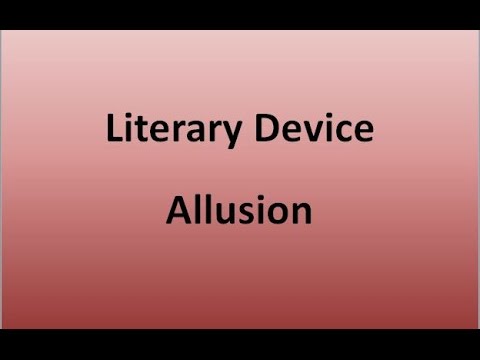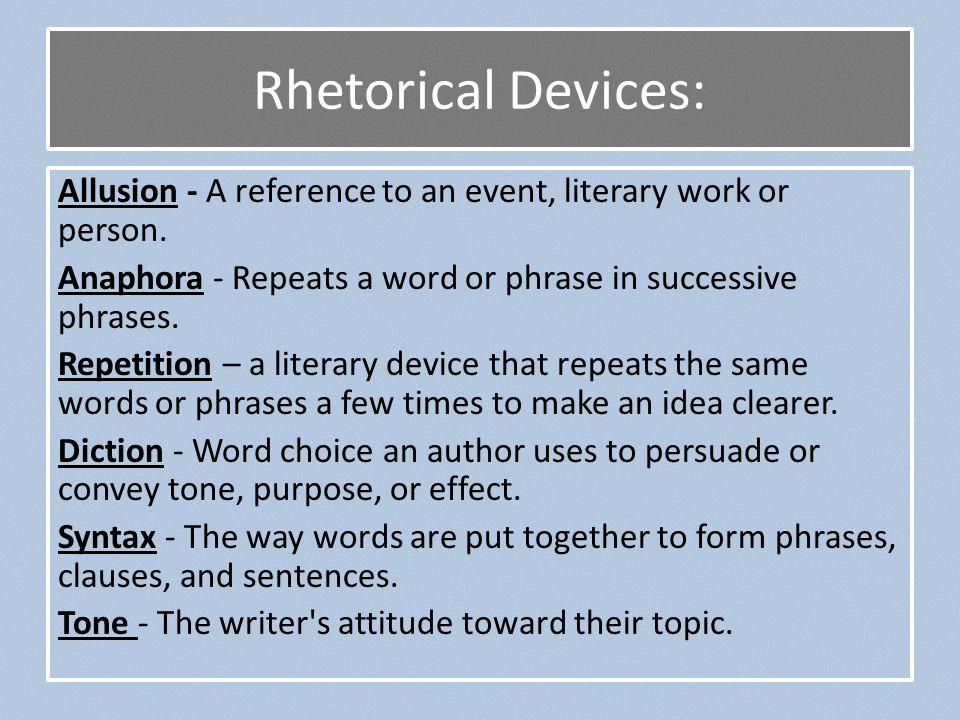Allusion is an effective and often utilized rhetorical device used to make quick references to people, places, and events that are easily recognizable by the reader. It’s a type of figurative language that can be used to enhance a text or speech by making it more interesting and relatable. By alluding to something familiar, the speaker or writer can convey their message more effectively while also providing context and depth to their writing.
Allusion is often used in literature, but it’s also commonly used in everyday conversations. For example, if somene says they “feel like they’re being watched like Big Brother” they are alluding to George Orwell’s novel 1984 which features a totalitarian government that constantly monitors its citizens. This allusion helps illustrate the speaker’s feelings without having to explain them in detail.
In addition to being a powerful tool for conveying meaning and emotion, allusions can also help establish connections between different texts or ideas. By referencing one text within another, the reader can better understand how texts influence each other and how certain themes have been explored throughout history.
There are sveral types of allusions including historical, mythological, literary, and religious allusions. Historical allusions refer to past events such as wars or figures from history such as Julius Caesar or Alexander the Great. Mythological allusions reference ancient myths such as Pandora’s box or Hercules. Literary allusions refer to works of literature such as Shakespearean plays or classic novels like Alice in Wonderland. Religious allusions refer to works of religious texts such as The Bible or The Koran.
Overall, understanding how to use allusion is an important skill for any writer or speaker looking to create interesting pieces of work that will resonate with their audience. Allusion adds depth and context while simultaneously poviding an entertaining way for readers and listeners alike to connect with your words on a deeper level!
What Is An Example of an Allusion?
An example of an allusion is when a person references a famous character, event, or figure in order to make a comparison or draw attention to something. For example, if someone says “He’s as slippery as an eel” they are making an allusion to the slippery nature of eels. Another example would be if someone said “She was as strong as Hercules” they are referencing the Greek demigod Hercules and his immense strength. Allusions can also be used to reference literature, art, or history. For example, if someone said “It was like bing in the land of Oz” they are making an allusion to the classic novel The Wizard of Oz by L. Frank Baum.

Exploring the Use of Rhetorical Allusion
Rhetorical allusion is a figure of speech that references an event, person, or object from history or literature in order to create a resonance with the reader or to apply a symbolic meaning to the character or object of which the allusion consists. It is different from other forms of allusion in that it does not directly quote or refer to the source material. Instead, it uses subtle hints and clues to evoke a feeling of familiarity in the reader. This can be done throgh word choice, imagery, metaphors, and other literary devices. By drawing connections between events and objects in different contexts, rhetorial allusions can add depth and richness to a text and help to make abstract concepts more concrete.
Understanding the Literary Device of Allusion
An allusion is a literary device that references a person, place, event, or another work of literature. Allusions can be used to draw attention to an idea or make a comparison beteen two different concepts. They can also be used to evoke an emotional response in the reader or create a sense of familiarity with the text. Allusions are often used in literature to provide context for a character’s thoughts and feelings, as well as to add depth and meaning to the plot. By making such references, authors are able to create vivid images that bring their stories to life.
Types of Allusions
Allusions are references to people, places, events, or works of literature that are used to create an effect or make a point in a conversation. There are four main types of allusions: historical, mythological, literary, and religious.
Historical allusions refer to past events or people from history such as wars, famous leaders, or important political moments. For example, if someone says “it’s like the Berlin Wall all over again,” that is a historical allusion referring to the Berlin Wall which was built in 1961 and stood for 28 years before it was demolished in 1989.
Mythological allusions refer to characters or stories from ancient mythology such as Zeus from Greek Mythology or the story of Icarus from Greek mythology. For example, if someone says “he thought he was invincible like Achilles,” then they are making a mythological allusion referring to the character Achilles who was known for his invincibility in Greek mythology.
Literary allusions refer to characters or stories from works of literature such as Romeo and Juliet from Shakespeare’s play Romeo and Juliet or Harry Potter from JK Rowling’s series of books. For example, if someone says “it’s like something out of a fairy tale,” then they are making a literary allusion referring to the genre of fairy tales which is popular in literature.
Religious allusions refer to stories or figures from religion such as Jesus Christ from Christianity or Moses from Judaism. For example, if someone says “it’s like parting the Red Sea,” then they are making a religious allusion referring to Moses who parted the Red Sea according to Jewish tradition.
The Use of Allusion in Sentences
An allusion is a figure of speech that makes an indirect reference to a person, place, event, or another work of literature. An example of an allusion sentence is: “He was so determined to finish the job, it was like he had the strength of Hercules.” This sentence compares the determination of the subject to that of the mythical hero Hercules, making an allusion to his strength and courage.

Identifying Allusions
An allusion is a figure of speech in which an author or speaker refers to a person, place, thing, event, or aother piece of literature. To identify an allusion, it is important to look for clues within the context of the sentence or paragraph. For example, if a character in a novel says something like “I’m feeling like Odysseus in this situation” then this could be an allusion to the Odyssey by Homer. Allusions often have a symbolic meaning and are used to help make a comparison between two different situations. By looking out for references to historical figures, events, literature and mythology you can identify an allusion. Additionally, it is helpful to note any words that create a strong visual image as these could be another form of allusion.
The Purpose of Using Allusion
Allusion is used as a literary device to add depth and context to a work. By referencing other works, the author can make associations with those works and draw readers in, creating an engaging and immersive experience. Allusions can also help enhance the characterization of characters and create meaningful connections betwen themes in different stories. Allusions can also be used to add humor or irony to a work, allowing the author to subtly comment on social issues without explicitly stating their opinion. In addition, allusions can provide insight into the author’s influences and help readers better appreciate the underlying themes or messages of a work.
Examples of Rhetoric
Logos: Logos is an appeal to logic, using facts and evidence to make an argument. Examples include using statistics, citing expert sources, and proviing logical explanations for a claim.
Ethos: Ethos is an appeal to ethics or credibility. It relies on the speaker or writer’s reputation or authority on the subject matter in order to persuade an audience. Examples of this include referencing past accomplishments or quoting experts in the field.
Pathos: Pathos is an appeal to emotion, designed to evoke a feeling from the audience that can be used to support a point of view. Examples of this include using vivid language, telling stories, and highlighting potential outcomes of the reader taking action.
Understanding the Meaning of an Allusion
A good allusion is a reference to an external source that fits seamlessly into the context of the text. It shold be meaningful to the author and should add depth and complexity to their work. For example, an author may reference a classic work or event, such as William Shakespeare’s Hamlet or the Battle of Thermopylae, in order to illustrate a point or draw a comparison. Allusions can also serve to create an atmosphere or evoke emotion in readers, such as referencing a beloved song lyric or beloved poem. Ultimately, an allusion should be appropriate for its context and help the reader gain insight into the author’s perspective.

Source: slideplayer.com
The Use of Allusion in Harry Potter
Allusion is used troughout Harry Potter to reference characters, themes, and events from classic literature and mythology. For example, the names of some of the characters—such as Sirius Black, Voldemort, and Dumbledore—are allusions to Greek gods or figures from classical literature. In addition, many of the characters in Harry Potter are based on archetypal figures from literature and mythology, such as Hermione Granger being a modern version of Athena.
Moreover, several episodes in the books contain direct references to Shakespeare, such as Draco Malfoy’s hesitation to kill Dumbledore being reminiscent of Hamlet’s struggle with killing Claudius. The “Weird Sisters” band at the Yule Ball in Goblet of Fire is another direct reference to Macbeth. Allusions like thse serve to enrich the Harry Potter universe by connecting it with its literary predecessors.
Conclusion
In conclusion, allusion is a powerful rhetorical device that can be used to evoke emotion and symbolism. It allows writers to make reference to existing works or stories without having to extensively explain the context. Allusions can also be used to create a sense of familiarity and shared understanding between writer and reader. When used effectively, allusions can help writers craft compelling, thought-provoking stories.
